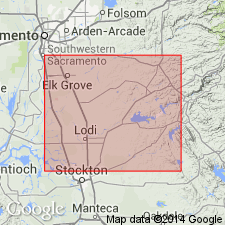
- Usage in publication:
-
- Arroyo Seco gravel*
- Modifications:
-
- Original reference
- Dominant lithology:
-
- Gravel
- AAPG geologic province:
-
- Sacramento basin
Summary:
Pg. 33, 49-55, pl. 1. Arroyo Seco gravel. Water-worn cobbles, gravel, and sand derived chiefly from pre-Cretaceous crystalline rocks. Is a pediment gravel that mantles the dissected Arroyo Seco pediment in Arroyo Seco Land Grant, along western front of Sierra Nevada. Thickness up to 19 feet. Contemporaneous sediments presumably exist to much greater thickness beneath cover in axis of California trough. Underlies Victor formation (new). Overlies gravel deposits of uncertain age; in some areas overlies Mehrten formation (new) and in others Laguna formation (new; Pliocene?). Fossils. Age is Pleistocene. [This is cited by Wilmarth as "in press."]
Named from Arroyo Seco Land Grant [along west front of Sierra Nevada] where formation is extensively preserved. [Type locality: Arroyo Seco Plain, a prominent geographic feature in Arroyo Seco Land Grant, 0.25 mi northeast of Wallace, in SE/4 sec. 15, T. 4 N., R. 9 E., Wallace 7.5-min quadrangle, Calaveras Co., Mokelumne River basin, northern CA.]
[Shown on map legend (O.P. Jenkins, 1938, Geol. map California, scale 1:500,000, California Div. Mines, sheet 4.]
Source: US geologic names lexicons (USGS Bull. 896, p. 78; USGS Bull. 1200, p. 144); GNU records (USGS DDS-6; Menlo GNULEX).
For more information, please contact Nancy Stamm, Geologic Names Committee Secretary.
Asterisk (*) indicates published by U.S. Geological Survey authors.
"No current usage" (†) implies that a name has been abandoned or has fallen into disuse. Former usage and, if known, replacement name given in parentheses ( ).
Slash (/) indicates name conflicts with nomenclatural guidelines (CSN, 1933; ACSN, 1961, 1970; NACSN, 1983, 2005, 2021). May be explained within brackets ([ ]).

